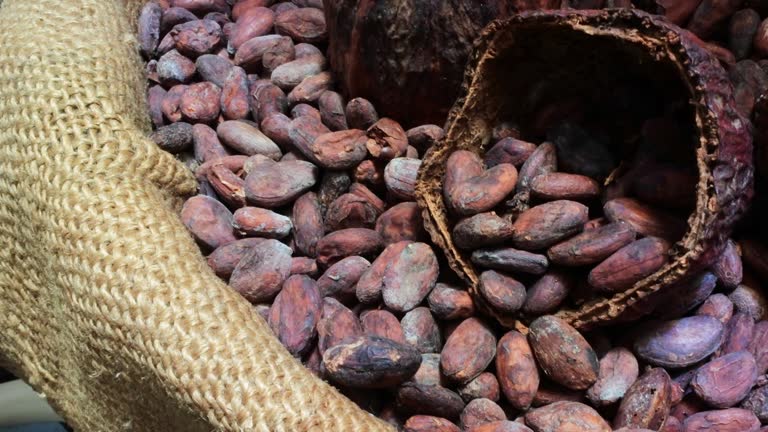Discovering reliable sources for premium chocolate beans in Canada has become increasingly important for craft chocolate makers, culinary professionals, health-conscious consumers, and anyone passionate about creating exceptional chocolate products from scratch. As the bean-to-bar movement continues gaining momentum across Canada and consumers become more educated about ingredient quality, understanding where to find authentic chocolate beans and how to evaluate their quality ensures you can create products that truly stand out in flavor, nutrition, and overall excellence.
Understanding Chocolate Beans and Their Appeal
The term “chocolate beans” refers to the seeds of the Theobroma cacao tree—the raw material from which all chocolate products are ultimately created. These beans, harvested from large pods growing directly on cacao tree trunks and branches, contain the fundamental flavors and compounds that, through proper processing, transform into the chocolate we know and love.
Working with whole chocolate beans rather than pre-processed chocolate products offers remarkable advantages. You gain complete control over roasting levels, which dramatically impact flavor development. You can select specific bean origins to showcase unique terroir characteristics. You determine sweetness levels, texture, and any additional flavors or inclusions. This level of control simply isn’t possible when starting with commercial chocolate products.
Beyond creative control, chocolate beans offer exceptional nutritional value, particularly when minimally processed. They contain impressive concentrations of antioxidants called flavonoids, essential minerals including magnesium and iron, fiber, and various compounds that may support cardiovascular health and cognitive function. For health-conscious Canadians, working with whole beans ensures maximum nutritional retention while avoiding unnecessary additives.
The educational aspect of working with chocolate beans appeals to many buyers. Understanding the entire process from bean to bar provides deep appreciation for chocolate as an agricultural product influenced by growing conditions, post-harvest handling, and processing techniques. This knowledge transforms chocolate from a simple commodity into a complex, fascinating food with infinite variations.
The Canadian Market for Chocolate Beans
Canada’s specialty food landscape has evolved significantly, creating robust demand for premium chocolate beans across diverse customer segments. Urban centers like Vancouver, Toronto, Montreal, and Calgary host thriving communities of chocolate makers and food artisans who have elevated expectations for ingredient quality and sourcing transparency.
This growing market has encouraged specialized suppliers to curate chocolate bean selections specifically for Canadian buyers, considering factors like popular origins, quality standards, appropriate quantities for different customer types, and the logistical challenges of serving a geographically vast country with extreme seasonal climate variations.
The accessibility of chocolate beans within Canada has improved dramatically as suppliers recognize the opportunity to serve both professional and enthusiast markets. What once required international ordering or specialty connections now often involves straightforward domestic purchasing with all the advantages that Canadian sourcing provides.
Quality Factors in Chocolate Beans
Evaluating chocolate bean quality requires understanding multiple factors that collectively determine whether beans will produce exceptional results or disappointing outcomes.
Genetic variety forms the foundation of quality. Fine flavor cacao varieties represent a small fraction of global production but offer complexity and nuance that commodity-grade beans cannot match. These premium varieties command higher prices but deliver correspondingly superior flavor profiles featuring fruity, floral, nutty, or spicy notes alongside fundamental chocolate taste.
Fermentation quality critically impacts final flavor. This post-harvest process, lasting typically five to seven days, develops the flavor precursors essential for good chocolate. Well-fermented beans, when cut open, reveal purple-brown interiors rather than the slate-gray of under-fermented beans. Proper fermentation reduces astringency and bitterness while developing complex flavor compounds.
Drying methodology affects both safety and flavor. Chocolate beans must reach 6-8% moisture content to prevent mold growth and ensure storage stability. The drying process—whether sun-drying or mechanical drying—must be controlled to avoid flavor damage from excessive heat while ensuring adequate moisture removal.
Physical characteristics reveal quality through visual inspection. Premium chocolate beans display uniform sizing within varieties, consistent coloring without discoloration, solid structure free from cracks or pest damage, and overall appearance indicating careful handling throughout processing and storage.
Advantages of Canadian Chocolate Bean Sourcing
Purchasing chocolate beans from Canadian suppliers offers multiple benefits that impact both product quality and purchasing experience.
Shipping efficiency ensures fresher products arriving faster. Domestic Canadian shipping typically completes within days rather than the weeks required for international transit. This speed means beans spend less time exposed to variable conditions and arrive in optimal condition.
Regulatory compliance is handled by suppliers who understand Canadian import requirements, food safety standards, and customs procedures. This expertise eliminates complexity and uncertainty for individual buyers while ensuring products meet all necessary standards before reaching customers.
Financial clarity comes from transactions in Canadian dollars, eliminating exchange rate fluctuations and conversion fees that can substantially increase costs when ordering internationally. Pricing remains transparent and predictable throughout the purchasing process.
Customer support quality typically exceeds international standards. Canadian suppliers operate during convenient business hours, understand local market conditions, and can provide guidance specific to Canadian climate zones, storage challenges, and usage applications.
Regional Origins and Flavor Characteristics
Chocolate beans from different growing regions offer distinctive flavor profiles that appeal to various preferences and suit specific applications.
South American origins, particularly Ecuador, Peru, and Venezuela, typically present fruity and floral characteristics with bright acidity and complex layered flavors. Ecuadorian beans often show delicate aromatic qualities. Peruvian varieties tend toward nutty, earthy notes with natural sweetness. Venezuelan beans, especially from renowned regions, rank among the world’s finest with exceptional complexity.
Central American and Caribbean chocolate beans from countries like Dominican Republic deliver classic chocolate flavor with nutty undertones and moderate acidity. These beans provide recognizable, approachable chocolate taste that works beautifully across diverse applications from eating chocolate to baking.
African origins offer robust, bold chocolate flavor with earthy characteristics. These beans provide intense chocolate presence suitable for applications requiring strong, straightforward chocolate taste without excessive fruity or floral complexity.
Diverse Applications for Chocolate Beans
Canadian buyers use chocolate beans across remarkably varied applications, each benefiting from starting with quality whole beans.
Bean-to-bar chocolate making represents the most comprehensive approach, involving roasting to develop flavor, winnowing to remove husks, grinding to create chocolate liquor, refining for smoothness, conching for texture development, tempering for proper crystallization, and molding into bars or other forms. This complete process allows chocolatiers to control every variable affecting final products.
Raw chocolate creation uses unroasted beans processed at low temperatures to preserve heat-sensitive nutrients. This approach appeals to health-conscious consumers seeking maximum nutritional value while still enjoying chocolate’s flavors and versatility.
Baking applications benefit from chocolate beans processed into nibs—simply beans that have been cracked and husks removed. These nibs add intense chocolate flavor and satisfying crunch to cookies, brownies, muffins, breads, and specialty pastries while allowing bakers to control sugar content.
Beverage applications use chocolate beans for making authentic hot chocolate from scratch, cold brew chocolate drinks, and as flavor components in specialty coffee preparations and craft cocktails. These uses showcase chocolate’s versatility beyond solid forms.
Health-focused applications incorporate chocolate beans into smoothies, energy balls, granola, and functional food products where their nutritional density and rich flavor provide both taste and wellness benefits.
Storage Considerations for Canadian Climates
Proper storage maintains chocolate bean quality and prevents deterioration that compromises flavor and usability. Canada’s diverse climate zones present unique challenges requiring attention to storage conditions.
Chocolate beans require cool, dry, dark storage away from strong odors they readily absorb. Ideal temperatures range between 15-18°C with relative humidity below 70%. These conditions prevent mold growth, fat bloom, and flavor degradation.
Airtight containers made from glass, food-grade plastic, or other non-reactive materials protect beans from humidity, oxygen exposure, and environmental odors. Proper containers are essential for maintaining optimal conditions throughout storage periods.
Seasonal variations affect storage requirements. Canadian winters generally create suitable indoor conditions, while summer heat and humidity demand careful attention to storage location selection and monitoring.
Making Informed Purchasing Decisions
When evaluating where to buy chocolate beans in Canada, consider multiple factors beyond basic price comparisons.
Supplier transparency about sourcing, processing, and handling demonstrates commitment to quality. Look for detailed product information including origin specifics, variety details, processing methods, flavor profiles, and usage recommendations.
Quality certifications provide additional assurance. Organic certification verifies beans were grown without synthetic chemicals. Fair trade certification indicates ethical farmer treatment. These certifications align purchases with values while often correlating with superior quality.
Conclusion
Finding reliable sources for premium chocolate beans in Canada empowers you to create exceptional chocolate products, explore creative culinary applications, and incorporate nutritious ingredients into your diet. By selecting Canadian suppliers who prioritize quality, transparency, and customer service, you ensure access to properly sourced and handled beans that meet your specific requirements.
The investment in quality chocolate beans delivers outstanding returns through superior flavor, consistent results, and the satisfaction of working with premium ingredients from their most fundamental form. Whether you’re crafting artisan chocolate, creating healthy treats, enhancing baked goods, or developing innovative products, starting with excellent chocolate beans from a trusted Canadian source establishes the foundation for success.





























